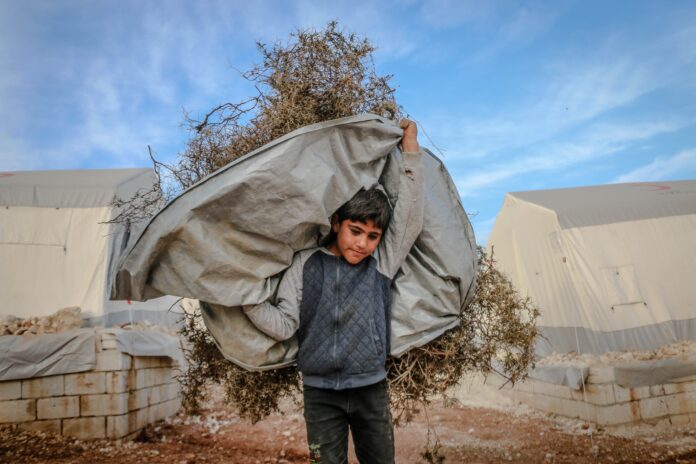June 12th marks World Day Against Child Labor. The picture of a child, bent double under a heavy sack. A child wielding a sharp machete, or crawling down into a dirty dangerous mine. These images elicit an immediate response. Yet, despite that immediate, visceral reaction, progress to end child labor has been slow. And that’s because actually addressing child labor requires addressing the underlying factors in our food system that exploit the most vulnerable instead of protecting them.
Child Labor in 2022 – a grim reality
Last year was declared the International Year for the Elimination of Child Labor. But instead of progress towards that goal, the statistics are headed in the wrong direction. In 2020, the number of children in child labor rose to 160 million around the world. That’s the first increase in 20 years, and is based on research done before the beginning of the pandemic.
Child labor is concentrated in the food and farming sector, with approximately 70% of child labor occurring on farms and plantations. That’s an estimated 108 million children on the front lines of the harms of the industrial food system. We know that toxic chemicals and hazardous pesticides are increasing pollution and decreasing biodiversity. They’re also bad for workers, and especially young people, who may experience not just immediate illness but also long-term, chronic effects on their developing minds and bodies.
This injustice is further compounded by the injustices of our global food system. As a declaration from a recent gathering of human rights leaders notes, “To this day, children working in agriculture continue to be exposed to hazardous pesticides that are banned in the country of export, resulting in abhorrent double standards and discrimination.”
Billionaires are Getting Richer
Since the beginning of the Covid-19 pandemic, experts have warned that the global crisis could drive child labor. Factory shut-downs, school closures, illness and death all push more children and young people to work to support themselves and their families.
And with two plus years of perspective, there’s another troubling trend: massive growing inequality, both between people and between nations. As the Oxfam paper “Profiting from Pain” notes, “Before the pandemic, inequality between rich countries and lower-income countries was falling and had been for three decades. COVID-19 has reversed this trend. Low- and middle-income countries now face a lost decade while rich nations once again pull ahead.”
Around the globe, the pandemic has hit hardest those already impacted by the historical legacies of colonialism and slavery. And those existing inequities are being exacerbated by policy decisions in response to the pandemic. There’s a massive transfer of wealth going on, and it’s impacting people both at the geopolitical level and at the personal level.
Our Food System Prioritizes Profits over Feeding People
Just as child labor is concentrated in the food system, so too is this growing inequality. Billionaires making money off food and agribusiness have seen their collective wealth soar 45% in the past two years, an increase of $382 billion.
Global food giant Cargill is an excellent example. Cargill is one of four companies who control over 70% of the global market for agricultural commodities, including wheat, soy, and cocoa. Rising market prices and speculation, fueled in part by the invasion of Ukraine as well as the pandemic, have meant record profits for the Cargill family heirs who own the company. Their combined wealth has risen 65% since 2020, growing by almost $20 million per day to a whopping $42.9 billion.
While the Cargill family has gotten rich, the rest of the world has not been so fortunate. Global food prices have soared 33.6% in the past year and continue to rise. Oxfam estimates that 263 million people could be pushed into extreme poverty this year because of these intersecting crises. This shock impacts those who can least afford it. People in low-income countries spend more than twice as much of their income on food as do those in richer countries. And poor people everywhere spend a higher percentage of their income on food than richer people do.
Once again, it’s painfully clear that the industrial food system is built to funnel profits up to just a few billionaires instead of prioritizing feeding hungry families.
Extractive Business is a Root Cause of Child Labor
One of the crops where the Cargill heirs have made their billions trading is cocoa. Meanwhile, West African cocoa farming families earn, on average, less than $1 per day. The gap is tremendous. And the extreme unfairness isn’t just a coincidence. The profits of these billionaires are built on the backs of poor farmers and workers.
Fueled by the extreme poverty, child labor on cocoa farms is on the rise. Cargill has known about the issue for decades. It’s been over two decades since they were one of the big cocoa traders to pledge to take action. They’ve been the subject of multiple lawsuits over their use of child labor (for more, listen to Episodes 6 and 7 of our For a Better World podcast where we break down the issues of money and power at play in the issue of child labor in cocoa with some of the people working to hold corporations accountable).
Despite sustained attention, Cargill continues to drag their feet on taking real action to address child labor (Cargill is not alone in this, the big chocolate companies are also failing to act on child labor). Instead of committing to paying true living incomes to cocoa farmers, Cargill continues to make them subsidize their profits through low prices. Further, Cargill lags behind the industry on some of the basics. Just 30% of their cocoa is traceable to the farmer cooperative it came from, per the Cocoa Barometer – a failure to take the fundamental first steps required for addressing supply chain issues.
Progress towards Ending Child Labor is Hampered by False Solutions.
It’s been over 20 years since big chocolate companies signed the Harkin-Engel protocol committing to ending child labor, and all the deadlines they set themselves have long passed.
Yet the issue is much bigger than cocoa. Across our food and farming system, working people and their children continue to be exploited. And the powerful interests that protect industry profit block progress on protections. A bill to close loopholes that allow children as young as nine to work nearly unlimited hours on U.S. farms has been re-introduced in the U.S. House of Representatives without action since 2001. That’s just one example of the ways that real action is bypassed in favor of weaker voluntary solutions.
Instead, corporations continue to back voluntary initiatives that just serve to gloss over the exploitation that’s baked into their business model. There is a recurring theme from the empty promises of Nestle’s Responsible Sourcing Standards to the recent B Corp Certification of Nestle’s Nespresso (despite child labor and human rights issues). In each case, there’s a rush to put a positive spin on a business model that fails to address the root causes of child labor instead of committing to the fair livelihoods and dignified work for all people, regardless of age.
To End Child Labor We Need to Strengthen Community-Led Solutions
Child labor is a symptom of the fundamental problem: Our food and farming systems, and our global economy as a whole, is fundamentally extractive. A few billionaires reap outsized profits from the exploited labor of people worldwide.
Last month, leaders from around the globe convened in Durban, South Africa, in a conference where they agreed to 49 key measures to address child labor. Running through the call to action is a strong thread: to address child labor, we need to strengthen communities to advocate for their own well-being and push back on extractive, exploitative systems.
Some of those measures include:
- Support for fundamental rights at work for all people of all ages, and ensuring that those rights are made real for those most likely to be excluded, including migrant workers, people discriminated against on the basis of race, caste, gender, etc.
- Real living incomes that allow families to thrive.
- Protections for the right to organize and collectively bargain as a bedrock for the guarantee of all other rights.
- Elimination of piece-rate pay for workers, that is, payment per bucket picked instead of per hour worked.
- Strengthening of cooperatives to build strong institutions for rural farmers and their families.
- Addressing the ways that child labor intersects with the key issues and inequities of our global economy, including addressing the climate crisis, universal social protections and public education, war and imperialism, migration, and gender equality, to name a few.
In short, to end child labor means making a real commitment to end the exploitative conditions and inequities that give rise to the conditions where child labor happens. Child labor is most common in the places where adult workers have the fewest legal protections – basic rights for all working people protect children.
Our global industrial food system is designed to extract profits from communities around the globe to enrich just a few billionaires at the top. There’s no single silver-bullet solution to address the consequences of that exploitative system on families, children, or our planet. But one of the key threads throughout is the need to support community-led initiatives as they build power and push back. Whether that’s strong cooperatives for rural farmers, or farmworker organizing, these efforts are some of the strongest tools to protect the rights of the most vulnerable – and build a society where all of us can thrive.










